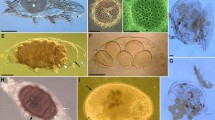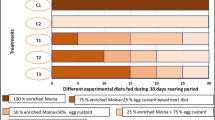Abstract
In June 1990, previously starved Lytechnius variegatus were fed a 5% fish meal-agar diet for 32 d at 20°C and 32‰. Stomach and intestine indices increased by 139 and 66%, respectively, with the most growth occurring by Day 16. The stomach had a faster growth rate than the intestine, as indicated by an increase in the stomach: intestine ratio. Gonadal growth did not begin until Day 16, after substantial gut growth. DNA and morphometric analysis revealed that cellular growth in the stomach and intestine was first hyperplastic and then hypertrophic. DNA concentration and histological examination indicated that the stomach was composed of large voluminous cells, and the intestine of small cells. The stomach of starved individuals contained numerous depressions that significantly decreased in number during growth. The number of depressions significantly increased in the intestine. Lipid concentration and amount were higher in the stomach, and increased during growth by 43 and 258%, respectively, by Day 32; little change in lipid occurred in the intestine. The stomach lipid:DNA ratio increased by 66% by Day 16, with little change in the intestine. The concentration of soluble protein remained constant in the stomach, but had decreased in the intestine by Day 16. The total energy stored in the stomach and the intestine increased by 152 and 66%, respectively, by Day 32. The stomach mucosa increased in thickness and appeared to decrease its surface area. These data suggest that the stomach constitutes the primary storage organ of the gut. The intestinal mucosa also inreased in thickness but remained thinner than the stomich while apparently increasing in surface area, suggesting an enhanced role in residual nutrient absorption and ranslocation, respiration or water ion-transport.
Similar content being viewed by others
Literature cited
Anderson, J. M. (1966). Aspects of nutritional physiology. In: Boolootian, R. A. (ed.) Physiology of Echinodermata. Wiley-Interscience, New York, p. 329–357
Baker, J. R. (1944). Biological fixation. In: Sumner, B. E. H. (ed.) Basic histochemistry. Wiley-Interscience, New York, p. 36
Binyon, J. (1972). Physiology of echinoderms. Pergamon Press, Oxford
Bishop, C. D. (1991). A biochemical and morphometric study of growth in the stomach and intestine of the regular sea urchin Lytechinus variegatus. M. S. thesis. University of Alabama at Birmingham
Bradford, M. (1976). A rapid and sensitive method for the quantification of microgram quantities of protein utilizing the principle of protein-dye binding. Analyt. Biochem. 72: 248–254
Brody, S. (1945). Bioenergetics and growth. Hafner Publishing Co. Inc., New York
Bryant, P. J., Simpson, P. (1984). Intrinsic and extrinsic control of growth in developing organs. Q. Rev. Biol. 59: 387–408
Buchanan, J. B. (1969). Feeding and the control of volume within the test of regular sea urchins. J. Zool., Lond. 159: 51–64
De Ridder, C. D., Jangoux, M. (1982). Digestive systems: echinoids. In: Jangoux, M., Lawrence, J. M. (eds.) Echinoderm nutrition. A. A. Balkema, Rotterdam, p. 213–234
Dische, Z. (1955). Color reactions of nucleic acid components. In: Chargaff, E., Davidson, J. (eds.) The nucleic acids. Academic Press, New York, p. 85
Dubois, M., Gilles, K. A., Gilles, J. K., Hamilton, J. K., Rebers, P. A., Smith, R. (1950). Calorimetric method for determination of sugars and related substances. Analyt. Chem. 28: 350–356
Freeman, N., Lindgren, F. T., Ng, Y. S., Nichole, A. V. (1957) Serum lipid analysis by chromatography and infrared spectrophotometry. J. biol. Chem. 227: 449–464
Fuji, A. (1961). Studies on the biology of the sea urchin. IV. Histological observation of the food canal of the sea urchin, Strongylocentrotus intermedius. Bull Fac. Fish. Hokkaido Univ. 11: 1–14
Giese, A. (1961). Further studies on Allocentrotus fragilis, a deep sea echinoid. Biol. Bull. mar. biol Lab., Woods Hole 121: 141–150
Giese, A. (1966a). On the biochemical constitution of some echinoderms. In: R. A. Boolootian (ed.) Physiology of echinodermata. Wiley-Interscience, New York, p. 757–796
Giese, A. (1966b). Lipids in the economy of marine invertebrates. Physiol. Rev. 46: 244–298
Holland, N. D., Ghiselin, T. (1970). A comparative study of gut mucus cells in thirty-seven species of the class Echinoidea (Echinodermata). Biol. Bull. mar. biol. Lab., Woods Hole 138: 286–305
Klinger, T. S. (1984). Feeding of a marine generalist grazer: Lytechinus variegatus (Lamarck) (Echinodermata: Echinoidea). Ph. D. thesis. University of South Florida, Tampa
Klinger, T. S., Watts, S. A., Forcucci, D. (1988). Effects of short term feeding and starvation on storage and synthetic capacities of the gut tissues of Lytechinus variegatus (Lamarck) (Echinodermata: Echinoidea). J. exp. mar. Biol. Ecol. 117: 187–195
Lawrence, J. M. (1967). Lipid reserves in the gut of three species of tropical sea urchins. Caribb. J. Sci. 7: 65–68
Lawrence, J. M. (1976). Patterns of lipid storage in post metamorphic marine invertebrates. Am. Zool. 16: 747–762
Lawrence, J. M., Hughes-Games, L. (1972). The diurnal rhythm of feeding and passage of food through the gut of Diadema setosum (Echinodermata: echinoidea). Israel J. Zool. 20: 131–138
Lawrence, J. M., Lawrence, A. L., Giese, A. (1966). Role of the gut as a nutrient-storage organ in the purple sea urchin (Strongylocentrotus purpuratus). Physiol. Zoöl. 39: 281–290
Lawrence, J. M., Lawrence, A. L., Holland, N. D. (1965). Annual cycle in the size of the gut of the purple sea urchin, Strongylocentrotus purpuratus (Stimpson). Nature, Lond. 205: 1238–1239
Lewis, J. B. (1964). Feeding and digestion in the tropical sea urchin, Diadema antillarum Philippi. Can. J. Zool. 42: 549–557
Lillie, R. D. (1954). Histopathologic technique and practical histochemistry. In: Sumner, B. E. H. (ed.) Basic histochemistry, Wiley-Interscience, New York
Ogue, M., Rosen, G. (1950). The nucleic acids of plant tissues. I. The extraction and estimation of deoxypentose nucleic acid and pentose nucleic acid. J. biol. Chem. 161: 293–303
Stott, F. C. (1955). The food canal of the sea urchin Echinus esculentus and its functions. Proc. zool. Soc. Lond. 125: 63–86
Tokin, I. B., Filimonova, G. F. (1977). Electron microscopy study of the digestive system of Strongylocentrotus droebachiensis (Echinodermata: Echinoidea). Mar. Biol. 44: 143–155
Watts, S. A., Lawrence, J. M. (1985). The effect of feeding and starvation on the level and content of nucleic acids in the pyloric caeca of Luidia clathrata (Say). In: Keegan, B. F., O'Conner, B. D. S. (eds.) Echinodermata. A. A. Balkema, Rotterdam, p. 571–576
Author information
Authors and Affiliations
Additional information
Communicated by J. M. Lawrence, Tampa
Rights and permissions
About this article
Cite this article
Bishop, C.D., Watts, S.A. Biochemical and morphometric study of growth in the stomach and intestine of the echinoid Lytechinus variegatus (Echinodermata). Marine Biology 114, 459–467 (1992). https://doi.org/10.1007/BF00350038
Received:
Issue Date:
DOI: https://doi.org/10.1007/BF00350038




